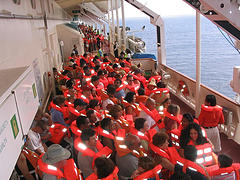How to Survive a Cruise Ship Sinking Disaster
14 January 2012Cruise ship disasters such as the sinking of the Costa Concordia are sensational news stories that may intimidate and frighten those who plan to take a cruise. Fortunately, disasters like this are rare and cruise ships operate under a number of international rules as well as having a variety of safety procedures and appropriate emergency equipment on board to handle unusual situations quickly and safely.
Why a boat or ship may sink
While cruise ships account for only a small percentage of the sea vessels that sink every year, it is believed that tens of thousands of boats sink each year. Many of the boats that sink are docked, but a lot of them sink at sea, from ferry boats to freighters to sailboats and yachts, and yes, even cruise ships occasionally sink.
One of the most common reasons a ship or boat can run afoul is due to navigational errors – simply put, this means the boat strikes an immovable object like a rocky island, a shallow reef, an ice pack, anything large enough to do damage to the boat’s hull (the body of the boat) and cause the boat to take on water. Cruise ships typically have highly sophisticated and highly reliable navigational systems, but even the most sophisticated electronic system can fail at times.
While Mother Nature likely has the first say in whether a small boat like a yacht, a ferry, or sailboat sinks, these smaller boats can also sink for a variety of reasons including low transoms, faulty drain plugs, cooling system leaks, and more.
What if the cruise ship you are traveling on starts to sink?
The standard evacuation signal is seven short horn blasts followed by one long horn blast. This indicates the captain and crew are telling you to start evacuating. The primary goal of any emergency evacuation is the safe and prompt removal of passengers and crew from the sinking boat.
- First and foremost, it’s critical to stay calm and remember your evacuation drill. All cruise ships and many of the commercial sailing operators will deliver a briefing at the start of your trip telling you exactly how to behave and what to do during an evacuation. On a larger boat, it’s even more important to stay calm because panic can cause people to stampede and injure other passengers. Remember, larger boats take longer to sink, so there is more time. Stay calm.
- Avoid the elevators completely as electrical systems may fail, and use the stairs. Focus your efforts on finding the quickest route to the lifeboats.
- If the boat begins to tilt, it can make navigating the passageways confusing and difficult. Use the available handrails and watch for objects that may be loose and start to slide. If you are in the path of a sliding object, use the larger, fixed objects as added protection by positioning yourself behind them.
- Put on your life jacket, secure the life jackets of those near you, and get to the lifeboats as promptly as possible. The International Maritime Organization requires that all cruise ships be able to get passengers in lifeboats and lowered into the water within 30 minutes of their gathering on deck. The typical crew on a cruise ship practices this a number of times, so it’s important to rely on crew and captain instructions.
Damian Tysdal is the founder of CoverTrip, and is a licensed agent for travel insurance (MA 1883287). He believes travel insurance should be easier to understand, and started the first travel insurance blog in 2006.

